
A daylily, day lily or ditch-lily is a flowering plant in the genus Hemerocallis, a member of the family Asphodelaceae, subfamily Hemerocallidoideae, native to Asia. Despite the common name, it is not, in fact, a lily, nor does it specifically grow in ditches. Gardening enthusiasts and horticulturists have long bred Hemerocallis species for their attractive flowers; a select few species of the genus have edible petals, while some are extremely toxic. Thousands of cultivars have been registered by the American Daylily Society, the only internationally recognized registrant according to the International Code of Nomenclature for Cultivated Plants (ICNCP).. The plants are perennial, bulbous plants, whose common name alludes to its flowers, which typically last about a day.

Rhinanthus minor, known as yellow rattle, is a herbaceous wildflower in the genus Rhinanthus in the family Orobanchaceae. It has circumpolar distribution in Europe, Russia, western Asia, and northern North America. An annual plant, yellow rattle grows up to 10–50 centimetres (3.9–19.7 in) tall, with upright stems and opposite, simple leaves. The fruit is a dry capsule, with loose, rattling seeds.

The water-plantains (Alismataceae) are a family of flowering plants, comprising 20 genera and 119 species. The family has a cosmopolitan distribution, with the greatest number of species in temperate regions of the Northern Hemisphere. Most of the species are herbaceous aquatic plants growing in marshes and ponds.
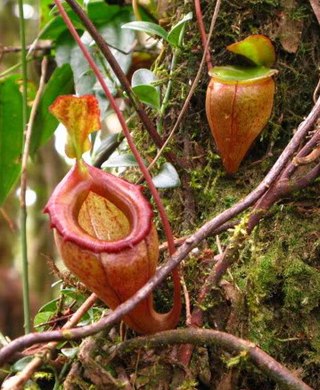
Nepenthes flava is a tropical pitcher plant endemic to northern Sumatra, where it grows in montane forest at 1800–2200 m above sea level.

Pimelea flava is a species of flowering plant in the family Thymelaeaceae and is endemic to south-eastern Australia. It is a shrub with narrowly elliptic to egg-shaped leaves arranged in opposite pairs, and compact clusters of 9 or more flowers with 2 or 4 elliptic to circular involucral bracts at the base. The flowers and bracts are white or yellow, depending on subspecies.

Orobanche minor, the hellroot, common broomrape, lesser broomrape, small broomrape or clover broomrape, is a holoparasitic flowering plant belonging to the family Orobanchaceae. It is one of about 150 non-photosynthetic plants in the genus Orobanche that parasitize autotrophic plants.

Parentucellia viscosa is a species of flowering plant in the family Orobanchaceae known by the common names yellow bartsia and yellow glandweed. It is native to Europe, but it can be found on other continents, including Australia and North America, as an introduced species.
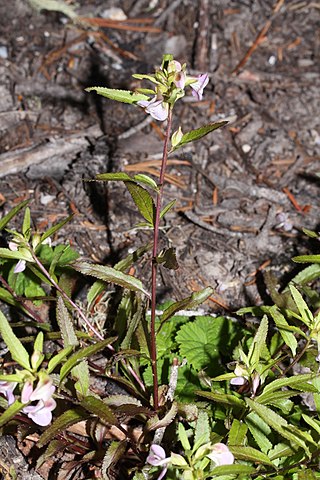
Pedicularis racemosa is a species of flowering plant in the family Orobanchaceae known by the common names sickletop lousewort and leafy lousewort. It is native to western North America, where it grows in coniferous forests. This is a perennial herb producing several stems up to 80 centimetres (31 in) tall, greenish to dark red in color. The leaves are up to 10 centimetres (4 in) long, linear in shape and lined with teeth. The inflorescence is a small raceme of flowers occupying the top of the stem. Each white to light purple or yellow flower is up to 1.6 centimetres long and is divided into a curved or coiled beak-like upper lip and a wide three-lobed lower lip. The fruit is a capsule over a centimeter in length containing smooth seeds.
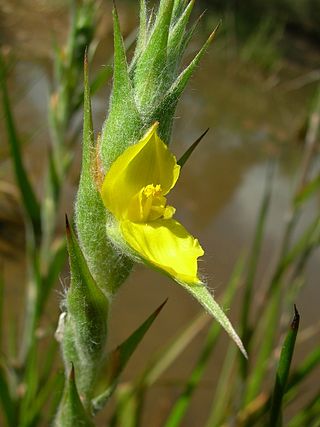
Philydrum is a genus of tufted, herbaceous, aquatic macrophyte plants, one of three genera constituting the plant family Philydraceae.

Limnocharis flava is a species of aquatic flowering plant which is native to Mexico, Central America, South America, Cuba, Haiti and the Dominican Republic but widely naturalized in southern and southeastern Asia: India, Sri Lanka, Cambodia, Burma, Thailand, Vietnam, Indonesia, Malaysia, Brunei and southern China.

Vachellia flava, synonym Acacia ehrenbergiana, is a species of drought-resistant bush or small tree, commonly known as salam in Arabic. It is found in the Sahara, the northern Sahel, parts of East Africa, the Arabian Peninsula and Iran.

Aeginetia indica, commonly known as Indian broomrape or forest ghost flower, is a holoparasitic herb or root parasite of the plant family Orobanchaceae. It grows in moist deciduous and semi-evergreen forests of tropical and subtropical Asia and New Guinea. It parasitises plants of the families Cannaceae, Commelinaceae, Cyperaceae, Juncaceae, Poaceae, and Zingiberaceae.
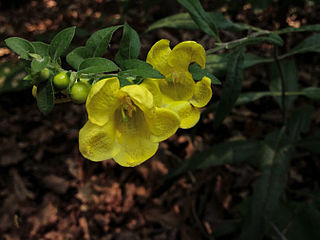
Aureolaria virginica, the downy yellow false foxglove or downy oak leach, is a perennial forb native to the eastern United States and Canada, which produces yellow flowers in summer.
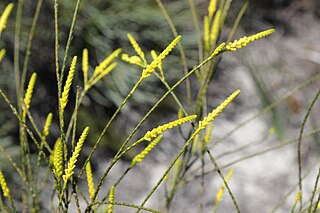
Micromyrtus flava is a species of flowering plant in the family Myrtaceae and is endemic to the south-west of Western Australia. It is a slender, erect shrub with spreading stems, narrowly-elliptic leaves and yellow flowers.

Aureolaria levigata, commonly known as entireleaf yellow false foxglove or Appalachian oak-leech, is a species of flowering plant in the family Orobanchaceae. It is native to much of the Appalachian Mountains and surrounding areas in the eastern United States. It is also found in a disjunct population in southwestern Mississippi.
Huberantha flava is a species of plant in the family Annonaceae. It is native to The Philippines. Elmer Drew Merrill the American botanist who first formally described the species, using the basionym Polyalthia flava, named it after its brilliant yellow flowers.
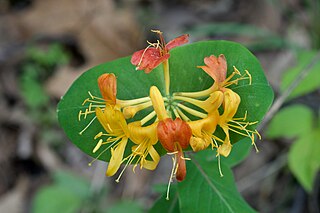
Lonicera flava is a species of honeysuckle native to the central and eastern United States. It is a woody vine with yellow-orange flowers that are slightly fragrant.
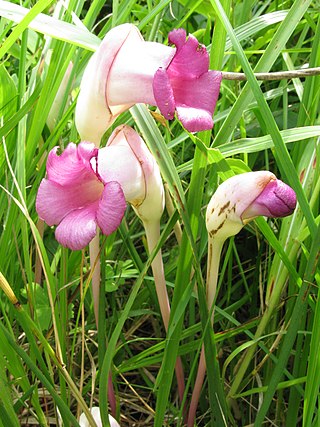
Aeginetia is a genus of plants in the broomrape family Orobanchaceae, native mostly to tropical Asia and also Cameroon.

Rhinanthus glacialis, commonly known as the aristate yellow rattle or glacier rattle, is a herbaceous plant species in the family Orobanchaceae, formerly classified as a member of the family Scrophulariaceae. This European species is primarily inhabiting the Central Europe.

Romulea flava, also known by its common name greenbract froetang, is a species of flowering plant in the iris family Iridaceae.


















